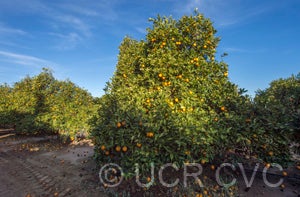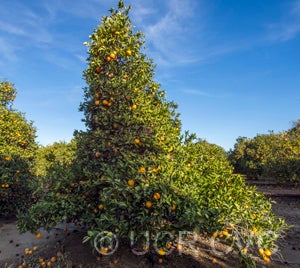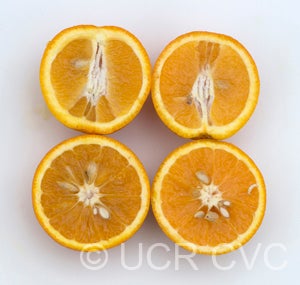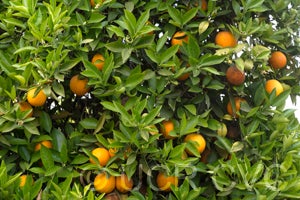Citrus sinensis (L.) Osbeck RUTACEAE
CRC 71
PI 539651
Source
Received as budwood from .D. Hubbard, San Fernando, CA, 1910.
Parentage/origins
Parents unknown. Jaffa was introduced into Florida by H.S. Sanford in approximately 1883, presumably by seed.
Rootstocks of accession
Carrizo citrange, C-35 citrange
Season of ripeness at Riverside
January to March
Notes and observations
JEC: Buds secured 6/07/10 from the home orchard of C.D. Hubbard. The tree from which the buds were taken, he claims to be an especially good one, holding its color late and not puffing. It is possible that this is nothing very extra."
3/23/1987, EMN: Jaffa & Joppa look similar externally but Jaffa is seedier and sweeter at this time. Both are typical sweets, not Shamouti-like.
Description from The Citrus Industry Vol. 1 (1967)
"Fruit medium-sized, globose to slightly ellipsoid or obovate; basal end commonly collared and with radial furrows; areole inconspicuous or absent; seeds comparatively few. Well-colored under favorable conditions. Rind medium-thick, finely pitted, and moderately pebbled. Flesh color light orange; medium-tender, juicy; flavor good. Stores poorly on tree, but ships rather well. Midseason in maturity.
Tree vigorous, upright, medium-large; foliage dense; cold-resistant; moderately productive, but with alternate bearing tendency.
In the literature and otherwise, this variety has sometimes been confused with Shamouti or Palestine Jaffa, the principal variety of Palestine and Israel, which it resembles only slightly. On the other hand, it somewhat resembles Joppa. Almost certainly both Jaffa and Joppa are clones of the Palestine beledi seeding group. Jaffa was introduced into Florida by H. S. Sanford about 1883, whether as budwood or seeds is not known, but presumably the latter. Joppa was named about 1877 in California as a seedling from seeds obtained in Joppa, Palestine. In this general connection, it is of interest to note that Shamouti is considered to have originated as a limb sport in a Palestinian beledi tree.
Because of its comparatively low seed content, cold resistance, and good quality, Jaffa early became popular in Florida and attained the status of a major midseason variety. The greater productivity and superior quality of Pineapple, however, soon caused it to lose favor, although Jaffa still remains important there and to some extent elsewhere. For processing, however, Jaffa's susceptibility to Alternaria blossom-end infection is a further cause for its decline in popularity in Florida."
Availability
Not commercially available in California.
USDA Germplasm Resources Information Network page for Jaffa sweet orange



